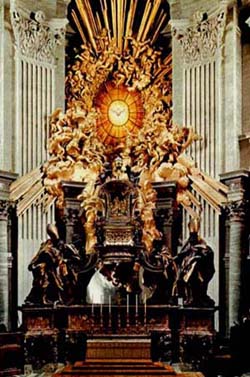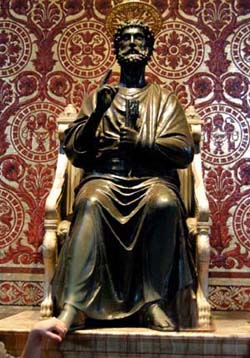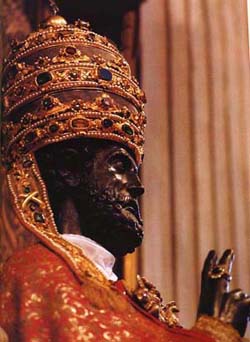 |
Special Feast Days
The Chair of St. Peter - January 18
Prof. Plinio Corrêa de Oliveira
It is well known that Pope Pius IX, who later became a great Pope, was liberal in the first phase of his pontificate. There were no liberal errors in his documents, but he adopted a series of very liberal attitudes.
At that time, Italy was divided into many small kingdoms, principates and free cities that made up the colorful, picturesque, efficient and stable Italy that we admire. The revolutionaries, however, had a plan to unify Italy and destroy those organic cells. They supported the liberal Pope and used to shout in the streets Viva Pio IX! as a rallying cry for the anarquists, socialists, members of the Mafia and Camorra, and others affiliated to the sect of Mazzini [the leader of the Carbonari, an Italian Masonry]. The cry - Viva Pio IX! - became therefore a symbol of the liberal and Masonic campaign to unify Italy by combating those organic small thrones.

The altar of the Chair of Peter by Bernini
|
In this difficult situation, where the Pope became the symbol of the Revolution, a great saint was present, St. John Bosco. The cry Viva Pio IX! had penetrated his schools, and often during class breaks the boys would call it out. In this way, the cry of the revolt entered the heart of his work with the youth.
How did he handle the situation? He forbade the pupils in his schools to shout Viva Pio IX! and ordered them to shout Viva il Papa! [Viva the Pope!] I think it was a superbly intelligent solution. Please note that this fact is recorded in the process of canonization of St. John Bosco and did not prevent him from becoming a saint. Nor did it prevent his work from being richly blessed by Divine Providence. So, today also, instead of shouting Viva Paul VI! we may well shout Viva the Pope!, and we will be following the example of a great saint.
At the heart of St. John Bosco's distinction is a very important difference between the Pope and the papacy, on one hand, and the person of the Pope, on the other, who is vulnerable to every human misery. He is also susceptible to error, to the measure that his teaching is not guaranteed by papal infallibility. A clear distinction exists between the man and the institution he represents. For this reason, it is not always the case to shout Viva Paul VI!, but instead we should be silent, weep and pray since this Pope in many ways represents the Revolution. It is always the case, however, to shout: Viva the Pope! and Viva the Papacy!
In this regard, this feast of the Chair of St. Peter is a very opportune feast, because it celebrates the infallible chair [cathedra] of St. Peter teaching to the entire world, and the Pope when he teaches infallibly from St. Peter's chair. [ex cathedra – from the chair]. Therefore, it is the infallibility, the orthodoxy of the Church that is celebrated in today's feast.

A pilgrim touching the foot of St. Peter at the Vatican Basilica. Below, the statue wears the papal symbols

|
In the rear altar in St. Peter's Basilica there is a bronze chair called Cathedra Petri [the Chair of Peter]. Over the altar is the famous Glory of Bernini to honor it. That bronze chair is empty and inside it is a small bench, whose photograph I saw, which is considered to be the original chair of St. Peter. Today's feast certainly is to venerate that small chair. But it is also to celebrate the fact that the ex cathedra papal teachings are infallible, and they stand over the entire Holy, Catholic, Apostolic and Roman Church.
In that same Basilica there is also another statue representing St. Peter. It is made of dark metal, probably bronze as well, and depicts him seated on a chair, holding the keys of the powers of the papacy. One of his feet extends out a bit past the marble base, at the height of the lips of the faithful. The pilgrims to Rome go there and kiss or touch the foot of St. Peter as a symbol of their obedience to the teachings of the Church. As a result of this devotion carried out through the centuries, the foot of St. Peter has worn thin. On one of the feasts of St. Peter - the feast of Ss. Peter and Paul - that statue is dressed in the Pope's solemn vestments and pontifical symbols including the tiara. The statue is there as if it were a living Pope.
What should we do on today's feast? Spiritually, we should kiss the foot of that statue of St. Peter. That is, we should renew our submission to this great and wise principle which is the infallibility of the authority that governs and teaches the Catholic Church. We should thank Our Lord through the intercession of Our Lady for the institution of that infallibility, which is the column that sustains the world. For without Papal Infallibility the Church, and consequently the world, would be irremediably lost. It is also the way to Heaven, because without the certainty of that infallibility, men would not have the sure knowledge of the right path to salvation.
We should also remember that fidelity to the Chair of St. Peter does not mean the unconditional acceptance of everything the person who exercises the papacy does. The Church instituted by Our Lord distinguishes the cathedra from the person. Therefore, the supreme fidelity to the Chair of St. Peter is to know this distinction and act accordingly.
If the Pope - like Pius IX - does something different from what the chair taught before, where do we stand? We stand forever - even to death - with the Chair of Peter, noting however that the chair is never completely removed from the person who exercises the papacy. The person can sometimes be away from the chair, but the chair does not exist without the person. We do not have just an abstract fidelity to the papacy. We have a concrete fidelity to the present day Pope to the measure that he is infallible and teaches things in accordance with the perennial Magisterium of the Catholic Church.


Watch a video illustration of this Saint of the Day article
here

  | | Prof. Plinio Corrêa de Oliveira | |
The Saint of the Day features highlights from the lives of saints based on comments made by the late Prof. Plinio Corrêa de Oliveira. Following the example of St. John Bosco who used to make similar talks for the boys of his College, each evening it was Prof. Plinio’s custom to make a short commentary on the lives of the next day’s saint in a meeting for youth in order to encourage them in the practice of virtue and love for the Catholic Church. TIA thought that its readers could profit from these valuable commentaries.
The texts of both the biographical data and the comments come from personal notes taken by Atila S. Guimarães from 1964 to 1995. Given the fact that the source is a personal notebook, it is possible that at times the biographic notes transcribed here will not rigorously follow the original text read by Prof. Plinio. The commentaries have also been adapted and translated for TIA’s site.
|
Saint of the Day | Home | Books | CDs | Search | Contact Us | Donate

© 2002- Tradition in Action, Inc. All Rights Reserved
|
 |
|